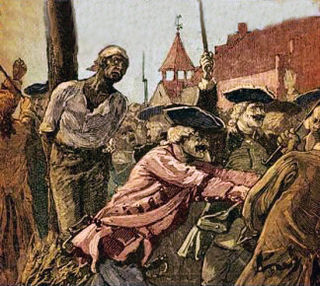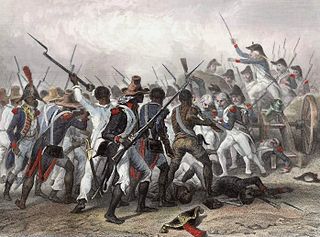Related Research Articles

Slavery in the colonial history of the United States refers to the institution of slavery as it existed in the European colonies which eventually became part of the United States. In these colonies, slavery developed due to a combination of factors, primarily the labour demands for establishing and maintaining European colonies, which had resulted in the Atlantic slave trade. Slavery existed in every European colony in the Americas during the early modern period, and both Africans and indigenous peoples were victims of enslavement by European colonizers during the era.

United States Colored Troops (USCT) were Union Army regiments during the American Civil War that primarily comprised African Americans, with soldiers from other ethnic groups also serving in USCT units. Established in response to a demand for more units from Union Army commanders, by the end of the war in 1865 USCT regiments, which numbered 175 in total, constituted about one-tenth of the manpower of the army. Approximately 20% of USCT soldiers were killed in action or died of disease and other causes, a rate about 35% higher than that of white Union troops. Numerous USCT soldiers fought with distinction, with 16 receiving the Medal of Honor. The USCT regiments were precursors to the Buffalo Soldier units which fought in the American Indian Wars.

Titus Oates was an English priest who fabricated the "Popish Plot", a supposed Catholic conspiracy to kill King Charles II.

The Popish Plot was a fictitious conspiracy invented by Titus Oates that between 1678 and 1681 gripped the kingdoms of England and Scotland in anti-Catholic hysteria. Oates alleged that there was an extensive Catholic conspiracy to assassinate Charles II, accusations that led to the executions of at least 22 men and precipitated the Exclusion Bill Crisis. During this tumultuous period, Oates weaved an intricate web of accusations, fueling public fears and paranoia. However, as time went on, the lack of substantial evidence and inconsistencies in Oates's testimony began to unravel the plot. Eventually, Oates himself was arrested and convicted for perjury, exposing the fabricated nature of the conspiracy.

Denmark Vesey was an 18th-century and early 19th century free Black and community leader in Charleston, South Carolina, who was accused and convicted of planning a major slave revolt in 1822. Although the alleged plot was discovered before it could be realized, its potential scale stoked the fears of the antebellum planter class that led to increased restrictions on both slaves and free blacks.
The Bye Plot of 1603 was a conspiracy, by Roman Catholic priests and Puritans aiming at tolerance for their respective denominations, to kidnap the new English King, James I of England. It is referred to as the "bye" plot, because at the time it was presented as a minor component of a larger plot.

Samuel Seabury was the first American Episcopal bishop, the second Presiding Bishop of the Episcopal Church in the United States of America, and the first Bishop of Connecticut. He was a leading Loyalist in New York City during the American Revolution and a known rival of Alexander Hamilton.

James Augustine Healy was an American prelate of the Catholic Church. He was the first known African American to serve as a Catholic priest or bishop. With his predominantly European ancestry, Healy passed for a white man and identified as such.

The Conspiracy of 1741, also known as the Slave Insurrection of 1741, was a purported plot by slaves and poor whites in the British colony of New York in 1741 to revolt and level New York City with a series of fires. Historians disagree as to whether such a plot existed and, if there was one, its scale. During the court cases, the prosecution kept changing the grounds of accusation, ending with linking the insurrection to a "Popish" plot by Spaniards and other Catholics.
Robert Johnson, a Shropshire native, was a Catholic priest and martyr during the reign of Elizabeth I.

John Augustus Tolton, baptized Augustine Tolton, was the first Catholic priest in the United States publicly known to be Black.

George Clarke was a colonial governor of New York.
Thomas Thwing (1635–1680) was an English Roman Catholic priest and martyr, executed for his supposed part in the Barnbow Plot, an offshoot of the fabricated Popish Plot invented by Titus Oates. His feast day is 23 October.
John Shert was an English Catholic priest and martyr, who was executed during the reign of Elizabeth I.
Daniel Horsmanden was a chief justice of the supreme court in the Province of New York and member of the governor's executive council.

The New York Slave Revolt of 1712 was an uprising in New York City, in the Province of New York, of 23 Black slaves. They killed nine whites and injured another six before they were stopped. More than 70 black people were arrested and jailed. Of these, 27 were put on trial, and 21 convicted and executed.
Ury or URY may refer to:

The situation of the Catholic Church in the Thirteen Colonies was characterized by an extensive religious persecution originating from Protestant sects, which would barely allow religious toleration to Catholics living on American territory. Nonetheless, Catholics were a part of America's history from the beginning, especially in Maryland, a colony founded by Catholics.
Capital punishment in New Jersey is currently abolished, after Governor of New Jersey Jon Corzine signed a law repealing it in 2007. Before this, capital punishment was used and at least 361 people have been executed.

William Augustine Williams was an African-American linguist, librarian, Catholic seminarian, and public figure. He was the first openly African-American Catholic seminarian—preceding Augustus Tolton—but was never ordained, having left Rome's Pontifical Urban University in 1862 after facing racist opposition to his prospective ministry in the United States.
References
- 1 2 Lindor, Douglas O., "The 'Negro Plot Trials': An Account", Famous Trials, University of Missouri - Kansas City, School of Law, 2009
- ↑ Kearns, William. "New Jersey." The Catholic Encyclopedia. Vol. 10. New York: Robert Appleton Company, 1911. 28 Jun. 2014
- ↑ Menenedez, Albert J. "Religious violence - American style", Institute for First Amendment Studies, Inc.
- ↑ Griffin, Martin I. J. "John Ury". Records of the American Catholic Historical Society of Philadelphia, vol. 39, no. 3, 1928, pp. 225–238. JSTOR
- ↑ Zabin, Serena R., ed. (2004). The New York Conspiracy Trials of 1741. Macmillan. ISBN 9780312402167.
- ↑ Zabin 2004, p. 112.